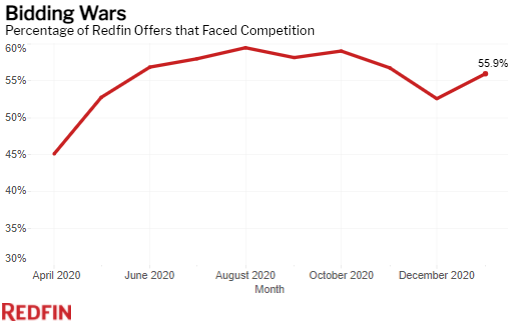Nationwide, 55.9% of Redfin offers for homes faced bidding wars in January, up from a revised rate of 52.5% in December. It marks the ninth consecutive month in which more than half of home offers written by Redfin agents faced competition.

An offer is considered part of a bidding war if a Redfin agent reported that it received at least one competing bid.
The pandemic and the resulting swell in remote work continue to push Americans to relocate to different areas and search for bigger homes with more outdoor space within their own neighborhoods. Pending sales were up 28% year over year in the week ending January 24, while the number of homes for sale was down 36%. Mortgage rates remain historically low, with the average 30-year fixed rate clocking in at 2.73% in the week ending February 4, another motivating factor for buyers.
“The number of homes for sale is at an all-time low and the supply shortage only seems to be getting worse,” said Redfin chief economist Daryl Fairweather. “With so few new listings hitting the market, I expect bidding wars to become more common and involve even more potential buyers as we head into the spring homebuying season. The best thing buyers can do is prepare: Prepare to see homes quickly as soon as they hit the market; prepare by talking to a lender and getting preapproved; and prepare by talking to your agent about how much a home you like is worth so you can go into a bidding war with your strongest offer tactics, but know when to back away if the price escalates more than you’re willing to pay.”
Nine out of 10 Redfin offers in Salt Lake City in January faced competition, the highest bidding-war rate of the 24 metros included in this analysis. It’s followed by San Diego (78.9%), the Bay Area (77.1%), Denver (73.9%) and Seattle (73.8%).
“Competition for homes is fierce and nearly everything is selling in five to six days,” said San Diego Redfin agent Charles Wheeler. “I’m advising my sellers to get a hotel for the weekend while potential buyers tour their house, and we review offers on Monday. Some homes get 30 to 40 tours in just two days and more than 10 offers. I tell buyer’s agents to give me their highest and best offers right off the bat, because the sellers are going to be so inundated they’ll only consider the top three or four offers. Buyers shouldn’t expect to negotiate on price right now—if they want to win a house, they need to pay the asking price or more.”
“Because of remote work, a lot of people are moving into San Diego from places like Los Angeles, the Bay Area and Seattle, which intensifies competition for homes,” Wheeler continued. “That counteracts the effect of people who are leaving the area due to high California taxes, retirement or a desire to be closer to family.”
Phoenix and Sacramento, two of the most popular destinations for Redfin.com users moving to a different metro area, also had bidding-war rates of more than 65%. Just about 66.5% of Redfin offers in both of those metros faced competition in January, partly due to the influx of buyers moving in from other areas.
At 26%, Atlanta had the lowest bidding-war rate of the metros included in this analysis, but still, more than one in four offers faced a bidding war.
Just over 65% of homes priced between $800,000 and $1 million nationwide faced bidding wars in January, the highest share of any price bucket. Next come homes priced between $1 million and $1.5 million—61.1% of those faced competition—and homes priced between $600,000 and $800,000 (60.9%).
“It used to be that lower-priced homes—anything under $800,000 in San Diego—were much more competitive than expensive homes,” Wheeler said. “But I’ve never seen demand like we have now on such a broad spectrum of prices. Now those more affordable homes, no matter where they’re located, are seeing steep competition, but so are homes in the $1.5 million to $2 million range. It’s partly because money is so cheap to borrow, even in the jumbo loan category.”
Homes priced below $200,000 were least likely to face competition, though they still had a bidding-war rate of 42.5%, followed by homes priced between $200,000 and $300,000 (48.4%) and $300,000 to $400,000 (52.6%).
Single-family homes had a bidding-war rate of 58.7% in January, the highest rate of any property type. They’re followed relatively closely by townhouses (54.8%), then condos, with a 44.6% rate.
Single-family homes have been especially popular since the onset of the pandemic and the surge in remote work, with homebuyers prioritizing space for offices and schoolwork.
Data for this report is based on information entered by Redfin real estate agents in Redfin’s internal customer management system. For each offer submitted on behalf of a homebuyer that is entered into the system by a Redfin agent, the agent is asked to indicate whether there were competing bids. The share of Redfin offers that faced bidding wars is calculated by dividing the number of offers that faced at least one competing bid from another buyer by the total number of offers entered into the system. This measure may undercount offers that faced bidding wars.

